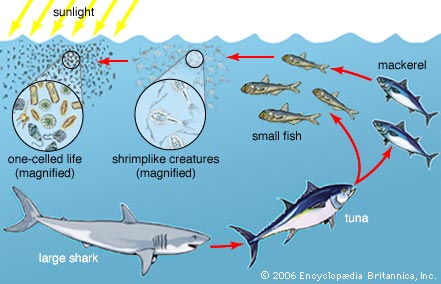Source google.com.pk
Tiger Shark Food Chain
What is a Food Chain? Food chains show how nutrients and food energy move through producers and consumers.
For this game, the loggerhead food chain consists of the following plants and animals:
Phytoplankton/Zooplankton (Plankton), Clams, Whelks, Turtles, and Sharks.
See the next slides for each part of the food chain.
Food Chain: Plankton
Plankton include microscopic plant and animal organisms that float or drift in great numbers in the ocean. Plankton are the start of most oceanic food chains.
There are many species of plankton and each has a characteristic shape. Plankton may be phytoplankton (plant-like organisms - producers) or zooplankton (animal-like organisms - consumers).
Loggerhead turtles eat plankton when they are very young and small juveniles. Clams also eat plankton.
To present the complex and energetic relationships between plants and animals in an ecosystem in a implified manner, scientists often choose the shape of a pyramid. Producers are at the base, consumers and reducers above them, with the latter also being at the beginning of the food pyramid for enabling the food cycle.
What, how much and how often do sharks eat?
Like all other animals, sharks need to eat to supply their organs and muscles with energy, to grow and to reproduce. The wide distribution of sharks in almost all seas and their successful existence for many millions of years are also due to sharks making use of many different food sources. While some specialise and have a rather limited range of prey, others are generalists or omnivores.
The maco shark is the fastest shark. It hunts at speeds of up to 70 km/h, and its prey are fast swimming fish such as tuna and swordfish. Some sharks, like the spiny catfish, have modified teeth to get to their prey (crustaceans) more easily, while other sharks, such as the whale, giant and megamouth sharks, have modified gill rakers or special teeth to filter their partially microscopic food (in particular plankton). It is unimportant if the prey moves fast or slow, hides or floats freely in the sea. Sharks have developed techniques to catch them all.
How much sharks need to eat for their energy balance is not known exactly yet and depends on shark species as well as degree of activity. Most species seem to be able to do with about 2-3% of their own body weight per day to cover their energy requirements. This is much less than most people think. These figures do not fit the image of an ever-eating monster. Some species even seem to put in proper feeding breaks. One reason seems to be their large and nutrient-rich liver and the special features of their stomach.
Since the stomach of a shark has only a limited pre-digestion function, the food in it is digested only slowly. Sharks are therefore able to use their stomach as a storage cabinet and to only take something from the “shelves” when they need it. This means that sharks can send food into their digestive tract at need. Some animals that died in captivity still had relatively well-preserved fish in their stomach even after long feeding breaks (or refusal to eat).










Tiger Shark Food Chain
What is a Food Chain? Food chains show how nutrients and food energy move through producers and consumers.
For this game, the loggerhead food chain consists of the following plants and animals:
Phytoplankton/Zooplankton (Plankton), Clams, Whelks, Turtles, and Sharks.
See the next slides for each part of the food chain.
Food Chain: Plankton
Plankton include microscopic plant and animal organisms that float or drift in great numbers in the ocean. Plankton are the start of most oceanic food chains.
There are many species of plankton and each has a characteristic shape. Plankton may be phytoplankton (plant-like organisms - producers) or zooplankton (animal-like organisms - consumers).
Loggerhead turtles eat plankton when they are very young and small juveniles. Clams also eat plankton.
To present the complex and energetic relationships between plants and animals in an ecosystem in a implified manner, scientists often choose the shape of a pyramid. Producers are at the base, consumers and reducers above them, with the latter also being at the beginning of the food pyramid for enabling the food cycle.
What, how much and how often do sharks eat?
Like all other animals, sharks need to eat to supply their organs and muscles with energy, to grow and to reproduce. The wide distribution of sharks in almost all seas and their successful existence for many millions of years are also due to sharks making use of many different food sources. While some specialise and have a rather limited range of prey, others are generalists or omnivores.
The maco shark is the fastest shark. It hunts at speeds of up to 70 km/h, and its prey are fast swimming fish such as tuna and swordfish. Some sharks, like the spiny catfish, have modified teeth to get to their prey (crustaceans) more easily, while other sharks, such as the whale, giant and megamouth sharks, have modified gill rakers or special teeth to filter their partially microscopic food (in particular plankton). It is unimportant if the prey moves fast or slow, hides or floats freely in the sea. Sharks have developed techniques to catch them all.
Graphic: H.Giese
The tiger shark is often described as omnivore or maritime garbage chute, but the term of well-equipped generalist would be more fitting. It hunts crustaceans and fish as well as maritime birds and mammals. Its teeth can cut, or rather saw through, tortoise shells or saw large pieces of meat from whale cadavers. Larger sharks also eat smaller sharks – of their own and other species.
Only a very small number of sharks is able to catch maritime mammals. Seals, dolphins and smaller whales can be prey for the great white shark. Contrary to the general opinion, sharks and dolphins often live close to each other. Since both animals hunt similar prey, it is hardly surprising.
Whales can usually only be caught by sharks if they are either inexperienced young or sick and weak animals, and orcas even hunt sharks. Seals are definitely part of the menu of large shark species, but have also been observed trying to bite a shark’s caudal fin and frightening it into fleeing. Reptiles such as tortoises also are eaten by some sharks. Birds are caught as well. On a small island near Hawaii, tiger sharks come to the bay every year, right when the young albatross population starts to fly. After their first attempts at flight, hatchlings often end up in the mouth of a tiger shark.
Only a very small number of sharks is able to catch maritime mammals. Seals, dolphins and smaller whales can be prey for the great white shark. Contrary to the general opinion, sharks and dolphins often live close to each other. Since both animals hunt similar prey, it is hardly surprising.
Whales can usually only be caught by sharks if they are either inexperienced young or sick and weak animals, and orcas even hunt sharks. Seals are definitely part of the menu of large shark species, but have also been observed trying to bite a shark’s caudal fin and frightening it into fleeing. Reptiles such as tortoises also are eaten by some sharks. Birds are caught as well. On a small island near Hawaii, tiger sharks come to the bay every year, right when the young albatross population starts to fly. After their first attempts at flight, hatchlings often end up in the mouth of a tiger shark.
Photo: G.Wegner
How much sharks need to eat for their energy balance is not known exactly yet and depends on shark species as well as degree of activity. Most species seem to be able to do with about 2-3% of their own body weight per day to cover their energy requirements. This is much less than most people think. These figures do not fit the image of an ever-eating monster. Some species even seem to put in proper feeding breaks. One reason seems to be their large and nutrient-rich liver and the special features of their stomach.
Since the stomach of a shark has only a limited pre-digestion function, the food in it is digested only slowly. Sharks are therefore able to use their stomach as a storage cabinet and to only take something from the “shelves” when they need it. This means that sharks can send food into their digestive tract at need. Some animals that died in captivity still had relatively well-preserved fish in their stomach even after long feeding breaks (or refusal to eat).
Tiger Shark Food Chain

Tiger Shark Food Chain

Tiger Shark Food Chain

Tiger Shark Food Chain

Tiger Shark Food Chain

Tiger Shark Food Chain

Tiger Shark Food Chain

Tiger Shark Food Chain

Tiger Shark Food Chain

Tiger Shark Food Chain

Tiger Shark Food Chain
No comments:
Post a Comment